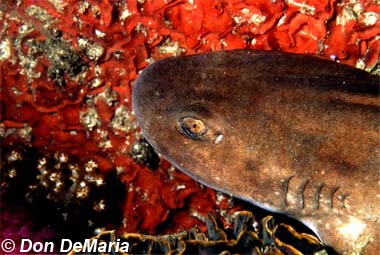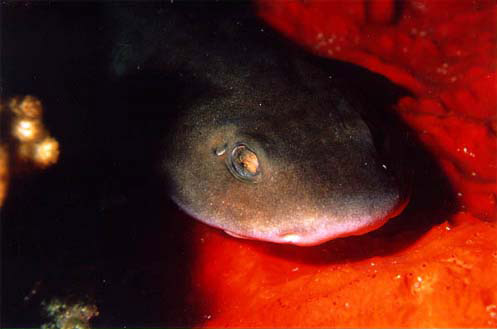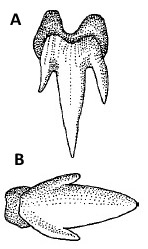Brown Shyshark

Haploblepharus fuscus
These elongated torpedo-shaped sharks rarely grow longer than 24 inches from rounded snout to stout caudal (tail) fin. They prefer resting on the rocky seafloor off of coastal South Africa, scavenging invertebrates and small fishes. Like most catsharks, they have oval cat-like eyes, and they are named shyshark because when threatened, they curl into circles and cover their faces with their tails. Considered harmless to humans because of their size, they are sometimes caught for food or shown in public aquariums.
Order – Carcharhiniformes
Family – Scyliorhinidae
Genus – Haploblepharus
Species – fuscus
Common Names
English language common names for this species include brown shyshark and brown shy shark. Other common names are brauner katzenhai (German), bruin skaamoog (Afrikaans), bruine schaamhaai (Dutch), roussette brune (French), and alitán marrón (Spanish). This species is referred to as a shyshark because they have been observed coiling themselves and covering their eyes with their tails when caught. This may be a defense mechanism, deterring predators from swallowing the shark.
Importance to Humans

While this species is not targeted by a directed fishery, the brown shyshark is utilized in subsistence fisheries. It is also considered a gamefish and is caught by sport fishers with rod and reel. In addition, this shyshark adapts well to captivity and may be observed at public aquarium facilities.
Danger to Humans
Due to is small size and feeding habits, this small shark is considered harmless to humans.
Conservation
Although the brown shyshark is a locally common species that is not targeted by commercial fisheries or utilized for its meat, there is some concern for its future as it likely appears in the bycatch of other fisheries. It may also be threatened by the degradation of its inshore habitat. Due to this species limited geographic distribution, any increase in bycatch mortality or habitat degradation could impact the entire population.
> Check the status of the brown shyshark at the IUCN website.
The IUCN is a global union of states, governmental agencies, and non-governmental organizations in a partnership that assesses the conservation status of species.
Geographical Distribution

The brown shyshark range is restricted in range to the southeast Atlantic Ocean from just west of Cape Agulhas to southern Natal in South Africa. This shark shares its range with the closely related H. edwardsii in the southeastern Cape region, however there is at least partial microhabitat separation between these two species. H. fuscus resides primarily in inshore waters in contrast to H. edwardsii which occurs in deeper waters offshore.
Habitat
This shark is typically found in shallow rocky intertidal zones to a depth of 110 feet (35 m) although it as been reported as deep as 436 feet (133 meters). It reportedly rests on the bottom substrate during the day. When threatened, this shark will curl its body into a circle with its tail over the eyes hence the name “shyshark”.
Biology

Distinctive Features
The largest of all catsharks, the stout-bodied brown shyshark has a broad head with large nasal flaps on the short snout and elongated cat-like eyes typical of the catsharks. The two dorsal fins are of equal size with the first dorsal fin located over the ends of the pelvic fins. The second dorsal fin originates over or slightly behind the anal fin midbase. The pectoral fins are moderately large. The anal fin is similar in size to the dorsal fins; the origin of the anal fin is located well behind the pelvic bases and the insertion separated from the lower caudal origin by a broad space subequal to the anal fin base. The caudal (tail) fin is short and broad.
Coloration
Coloration of the brown shyshark is yellow-brown dorsally, transitioning to yellowish in color on the ventral surface. Small light spots along with indistinct brown saddles may be visible in some specimens of this species.

Dentition
The teeth of the brown shyshark consist of a central cusp with a pair of smaller cusplets on the sides. The holotype of this species has 84 rows of teeth in the upper jaw and 83 rows of teeth in the lower jaw.
Denticles
The brown shyshark possesses thick skin covered with well-calcified dermal denticles. There are no crests of denticles on the caudal fins and no suprorbital crests on the cranium.
Size, Age, and Growth
The maximum reported length of this species is 27 inches (69.0 cm) total length (TL) for males and 29 inches (73 cm) TL for females. The average size of the brown shyshark is between 20 inches (50 cm) and 24 inches (60 cm). Sexual maturity is attained at lengths of 26 inches (65 cm) for males and 24-28 inches (60-70 cm) for females.
Food Habits
Prey items of the brown shyshark include marine invertebrates including lobsters, crabs, cuttlefish, and worms as well as small bony fishes.
Reproduction
This small shark is oviparous, laying two egg cases at a atime. Each egg case has long tendrils at the corners for attachment to the substrate. During development inside the egg, each embryo feeds solely on the yolk. In captivity, whelks have been observed piercing the egg cases and extracting the yolk.
Predators
Predators of the brown shyshark include larger sharks and fishes. The sharptooth houndshark Triakis megalopterus is a documented predator of this shark. Mollusks may feed on the egg cases.
Taxonomy
The brown shyshark was originally described as Haploblepharus fuscus by the South African ichthyologyist James Leonard Brierley Smith in 1950. There are no known synonyms for this species. The genus name Haploblepharus is derived from the Greek “haploos” meaning single and “blepharos” meaning eyelash. The species name fuscus is Latin for dusky or dark in reference to its brown coloration. Scyliorhinidae is the largest shark family with at least 15 genera and over 110 species. They are known as catsharks due to their elongated cat-like eyes, although a few species are referred to as dogfish.
Prepared by: Cathleen Bester